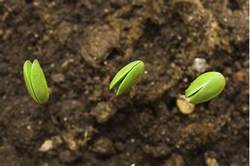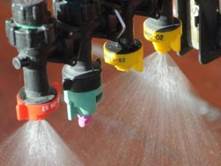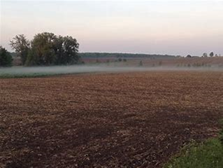Hello,
Inclement weather continues to keep planting season from getting off to a good start. Most of the wheat fields in the county have been top-dressed after green-up and if not yet done, will need to get done before jointing. Research has shown that yields will be reduced if nitrogen application is delayed after initial jointing. Also, jointed plants are prone to damage from application equipment, which may also reduce yields. See the attached article written by Hancock County OSU Extension Educator Ed Lentz about wheat nitrogen. I have also attached a trifold brochure about the new Ohio Sensitive Crop Registry system called Fieldwatch. As a pesticide applicator, you can create an account for free and monitor where sensitive crops such as fruits and vegetables are planted as well as where bees are located if they have been entered into the system. There is no charge to use this Fieldwatch system that Ohio and several other states are now using.
There is a new invasive insect that poses a threat to Ohio. Although it has not yet been found in Ohio, the Spotted Lanternfly has the potential to feed on about 70 different trees and cause damage. See the attached article written by Hardin County OSU Extension Master Gardener Volunteer Barb Snyder. I have also included photos of both the immature nymph and adult for you to be able to identify this new pest. If you suspect that you have found the spotted lanternfly in Ohio, please contact the Ohio Department of Agriculture at (614) 728-6270. As local farmers get ready to plant this year’s corn and soybeans, crop yields from the 2017 growing season have been released from the United States Department of Agriculture (USDA) National Agricultural Statistics Service. Although these crop production numbers are based on estimates, they are used for crop insurance and government reporting purposes. Read the attached news article to find out how Hardin County compares with area counties with this past year’s corn, soybean, and wheat crops.
Today (4/19) was the rescheduled day for pick-up of trees ordered from the Soil and Water Conservation District after the monthly SWCD meeting at the SWCD office. Monday (4/23) there is a Master Gardener Volunteers meeting starting at 7:00 pm at Harco Industries. Wednesday (4/25) is the first session of the Ohio Beef School, starting at 7:00 pm at the Extension office. The second session will be the following Monday (4/30), also starting at 7:00 pm at the Extension office. For topics of these presentations and registration information, see the attached flyer. As usual, see the agronomy articles below for timely information about ag crops.
Mark
Reduced Cost Manure Samples and Soil Samples Available to Pork Producers – Glen Arnold
The Ohio Pork Council, Brookside Labs, Menke Consulting Inc., and OSU Extension are teaming up to encourage pork producers to learn more about livestock manure and soil sampling by offering discounts on manure sample analysis and soil sample analysis through the end of 2018. Soil sample bags and manure containers have been mailed to approximately 18 county Extension offices in central and western Ohio. Sample containers are also available by stopping in at Brookside Labs. To find out how to take advantage of this opportunity, go to https://agcrops.osu.edu/newsletter/corn-newsletter/2018-07/reduced-cost-manure-samples-and-soil-samples-available-pork.
“What’s your number?” The SCN Coalition is launched – Anne Dorrance, Terry Niblack
Over the course of the next year, you will hear much about the pest, soybean cyst nematode. No stranger to Ohio, since the 1980’s, farmers in Ohio have been monitoring this pest. The first surveys, early 1990’s, SCN occurred sporadically in the state but some populations were very high. In a survey of fields in southern Ohio, high populations of SCN were found in fields where yields were consistently low. One of the more recent check-off funded projects, identified that more fields than 20 years ago has SCN. Read more at https://agcrops.osu.edu/newsletter/corn-newsletter/2018-07/“what’s-your-number”-scn-coalition-launched
Pattern Favors Only Slow Improvement – Challenging Weather to linger throughout April! – Jim Noel
The expected cold and wet weather pattern for spring that has been forecast since December continues. There will be some relief this week after a cold start to the week with temperatures 10 degrees below normal we will switch and see temperatures by the end of the week a good 10+ degrees above normal but when average out through Sunday April 15, we will return to about average temperatures for the week. Drying is expected as well through Friday with only minor precipitation events but another rain event is expected this weekend. There is a lot of uncertainty on amounts and placement so confidence is low but there is potential for some heavy rain in parts of Ohio. Go to https://agcrops.osu.edu/newsletter/corn-newsletter/2018-08/pattern-favors-only-slow-improvement-challenging-weather-linger to finish reading about the weather.
Avoiding Compaction – Alan Sundermeier
Heavy farm machinery compacts the soil, both on tilled ground and no-tilled ground. Compaction induced by agricultural machinery often affects soil properties and crop production. Axle load is the first factor that has to be considered in soil compaction, according to Randall Reeder, Ohio State University Emeriti and Dr. Sjoerd Duiker, Penn State Soil Specialist. Axle load is the total load supported by one axle, usually expressed in tons or pounds. Farm equipment with high axle loads on wet soil will cause compaction in the topsoil and subsoil, whereas low axle loads will cause compaction in the topsoil and the upper part of the subsoil only. Deep subsoil compaction can only partially be alleviated with subsoilers, and at considerable cost. Click on https://agcrops.osu.edu/newsletter/corn-newsletter/2018-08/avoiding-compaction to learn more about soil compaction.
OARDC Brach Station Two Inch Soil Temperatures – Greg LaBarge
During our recent survey of CORN Newsletter users, one item suggested for addition was a chart of soil temperatures in the spring. The Ohio Agricultural Research and Development Center (OARDC) Agricultural Research Station located throughout the state have 2 and 4 inch bare surface soil temperatures monitored on an hourly basis. The chart provided here summarizes the average daily two inch bare soil temperature from several stations. More complete weather records for the just passed day as well as long term historical observations can be found at http://www.oardc.ohio-state.edu/weather1/ . Observations include temperature, precipitation, different measures of degree day accumulation and other useful weather measures.
Mark A. Badertscher
Agriculture and Natural Resources Educator
OSU Extension Hardin County
1021 W. Lima Street, Suite 103, Kenton, OH 43326
419-674-2297 Office
hardin.osu.edu














